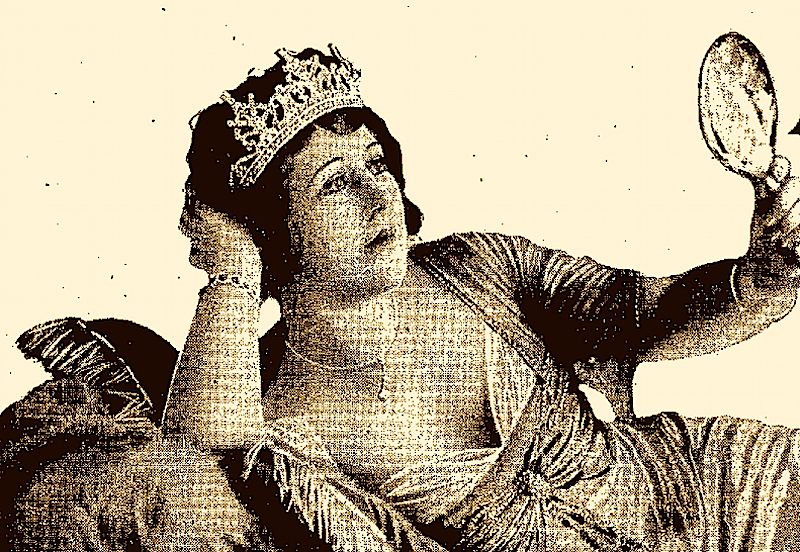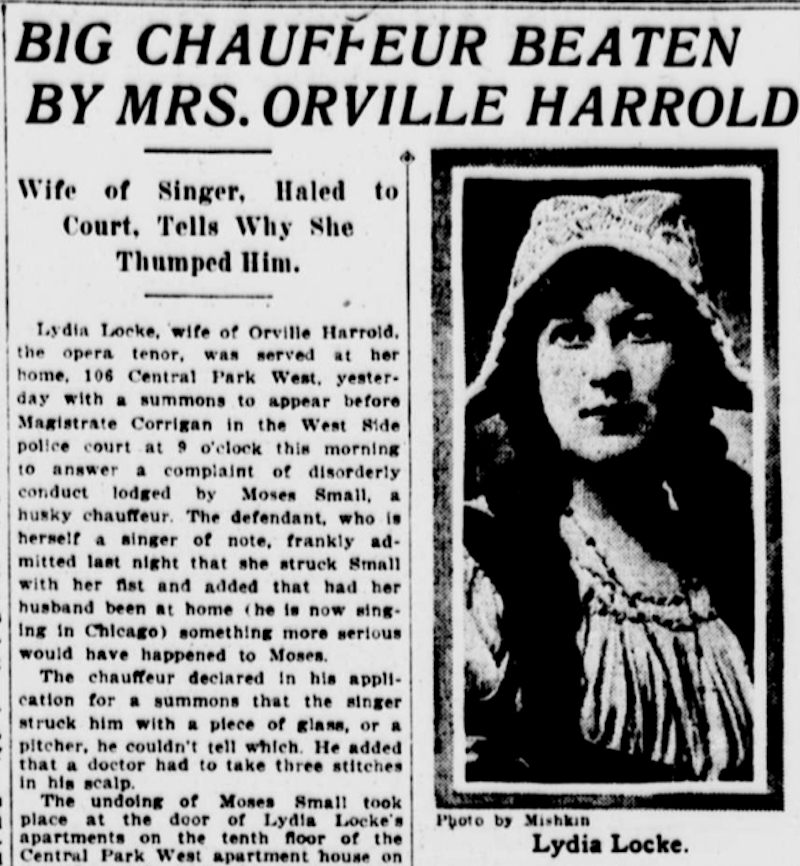Lydia Locke, the Turn of the Century Opera Singer With a Soap Opera Life

Lydia Locke, Turn of the Century Scandal Factory (All newspaper clipping images courtesy of Jim Logan and the Sleepy Hollow Cemetery)
Getting married seven times is a little excessive—especially when your marriages are accompanied by lethal gunplay, fake pregnancy, blackmail, and general social mayhem. Such was the life of Lydia Locke, a forgotten opera star of yesteryear whose eccentric antics outshone her talent as a mezzo soprano.
Lydia Locke was born in Hannibal, Missouri in 1886. There is little information about her early life, but by her early 20s she was a widely known opera singer, having performed around the world. It was at this point that Locke’s life began to become, in the words of Jim Logan, Superintendent of the Sleepy Hollow Cemetery where Locke is buried, “more soap opera than opera.”
Locke’s first groom was 43-year-old Reginald W. Talbot, who she married in Reno, Nevada in 1908. It was her first marriage, and Talbot’s fourth. One year later, things imploded. Known around town as “Lord Talbot” or “Prince Talbot,” Locke’s new husband was said to have led a plenty exciting life as a gambler and a raconteur, and demanded peace and quiet in his home life. But Locke was no wilting lily, and apparently after a long line of arguments, Talbot severely beat her. The very next morning, Locke had a meeting with her lawyer to discuss a divorce. “His Lordship” was also in attendance, and as their discussion got heated, Talbot hit Locke again. So she shot him three times with a pistol hidden in her fur muff.
Talbot died in the office.
Locke was arrested and tried for Talbot’s murder. Logan says the prosecution tried to vilify the singer as a “drug user and prostitute,” but thanks to a solid defense, and corroborating testimony from the couple’s house staff that Talbot was a serial abuser, Locke was acquitted. The Milwaukee Journal even said that the jury considered Talbot to have committed suicide.
Newly liberated, Locke continued to pursue her opera career, travelling to Chicago and Paris. During her work in these cities, she became acquainted with the man who would become her second husband: Orville Harrold, a tenor with the Oscar Hammerstein company. When Locke came into his life, Harrold was still married to the woman he had met back in his pre-opera days, when he was still driving a hearse. But now that he was a globe-trotting talent, Harrold was drawn to the vivacious and exciting Locke, just as she was drawn to him. In 1913, four days after Harrold had finalized his divorce from his hometown girl, he and Locke wed.

Ruh-roh.
Unfortunately, Locke’s life during her second marriage was no more smooth than during her first. According to Logan, the drama began quickly when Locke fired a shot at Harrold during their Italian honeymoon. The shot missed, but it was the starter pistol signaling years of strife to come. During their marriage, Locke took part in a number of altercations including punching her chauffeur in the face when he couldn’t give her 25 cents in change, taking part in a knock down tussle with a maid over rent, and suing a wealthy banker who she claimed hit her with his car, breaking her leg.
After years of marriage and minor court appearances, Harrold had had enough and sued Locke for divorce. Locke immediately countersued, also for divorce. Harrold, ready to wash his hands of his marriage to Locke, conceded the divorce to her. According to a 1925 article in the American Weekly, a San Antonio paper, Harrold said, “I don’t care who gets it, so long as it is gotten.”
During their divorce proceedings, a man named Arthur Marks, who Locke had met on a train, became involved as Locke’s “co-respondent.” Marks was a wealthy former executive of the B.F. Goodrich tire company, and, at the time of Locke’s second divorce, the president of an organ company. Shortly after Locke divorced Harrold, Marks became her third husband around 1918.
Marks and Locke’s marriage would become the longest of the opera singer’s eventful life so far, lasting for six years—officially. The details of their married life are scarce, although it is known that they adopted a son, but after six years of being wed, Marks is said to have begun showing signs of extreme fatigue, and was checked into a sanitarium. Locke immediately began calling the sanitarium to speak to Marks, but his doctor deflected her calls. According to that same 1925 article in the American Weekly, the doctor told Marks, “You’d better pack up. I can’t do anything for you. What you need is a divorce.” Marks seemed to agree.

Lydia Locke, Arthur Marks, and their officially adopted son.
Around 1924, Marks granted Locke a divorce in which she was awarded $300,000 and numerous pieces of property. But that wasn’t the end of their association. Post-divorce, Locke began harassing Marks with near constant phone calls day and night, until, finally, he offered her an additional $100,000 to not contact him for a year (some reports say the deal was for five years). Locke took the bribe. Sort of.
After a mere six months of silence, Locke came crashing back into Marks’ life—this time, holding a baby that she claimed was his. Marks began preparing to care for the child, at least financially, but, wary of the strange time frame for the baby’s birth, he set private detectives on the case. They discovered that Locke had in fact “borrowed” the infant boy from the Willow Maternity Hospital in Kansas City, under the assumed name Mrs. Ida Johnson.
The baby was returned to the hospital by authorities. Locke was not formally charged with any wrongdoing.
During her time away, in addition to setting up a fake paternity scam, Locke had married her fourth husband: her former personal assistant, Harry Dornblaser. Unsurprisingly, their marriage didn’t last long. Dornblaser bailed on their European honeymoon for reasons that are still unknown, fleeing back to the States and disappearing. As Logan tells it, he was found a few months later in an abandoned cabin near Cleveland, Ohio, dead from an apparently self-inflicted gunshot wound. No foul play was suspected.
Meanwhile, Locke was just now nearing the end of her agreed upon year of silence with third husband, Marks, which had been jeopardized by the fake baby debacle, but was still on the table (although the amount of her bribe had been lowered from $100,000 to $50,000). Unfortunately, Locke, possibly a bit emotionally unsound after Dornblaser’s abandonment, heard that Marks had found himself a new wife: one of Locke’s former friends. Locke sent the newlyweds a letter, which a 1932 article in the Milwaukee Journal said the courts described as “so obscene as to prohibit the publication of a single line.” The letter made a series of explicit claims about Marks’ new wife and her supposedly sexually deviant behavior. It was all false.

Yikes.
Locke was indicted by a federal grand jury for sending a “poison pen” letter through the mail, although neither this charge, nor a defamation suit Marks’ new wife filed against Locke, ever saw trial.
Through all of this, Locke maintained her opera career. After the years of strife and shenanigans with Marks, and another blip of a husband, Locke finally married her fifth husband in 1927. This latest man was a former Balkan count named Carlo Marinovic. Locke’s marriage to the “Count” was no more easy than any of her others. After three years of marriage, Locke returned from a Parisian shopping trip to flaunt her new purchases. Marinovic apparently couldn’t take it, and began throwing her new furs out the window before storming out and heading back to the Balkans. The last straw would be when Locke found that he was cheating on her with yet another of her friends. Foregoing the fake babies and lawsuits, Locke simply divorced him in the early 1930s.
According to Logan, Locke’s sixth husband is something of a mystery. In fact, the only reason he is thought to have existed is because the local historical society in Yorktown, New York, where she spent the later years of her life, lists her as having seven husbands. Her seventh marriage certificate also lists the nuptials as her seventh. Huh.
Speaking of, Locke’s seventh and final marriage was to a man named Irwin Rose. Locke’s final husband was a successful businessman and real estate mogul, and after marrying in 1954, the two settled down in Yorktown. Decades previous, in 1916, Locke had purchased 1,000 acres of land there, including a tall promontory from which the New York City skyline could be seen. Known as Locke Ledge, the property included a 26-room mansion where the couple lived, and a bustling inn onsite, which they operated.
Even with a new life of relative domesticity, Locke never dropped her badass persona. Logan says that during her later years, Locke was known to be chauffeured around town wearing nothing but one of her expensive furs. She was also known to appear at town hall meetings in the same bold outfit.
Locke and Rose remained together until Lydia’s death in 1966 of natural causes. Their mansion burned down in 1966, and the Locke Ledge property has since been parceled up for different uses, erasing most any trace of Lydia Locke’s life there. Her tabloid life lives on in archives, old newspapers, and the tour that visits her grave, but other than that her legacy is almost completely forgotten. Celebrity is fleeting; scandal lasts a lot longer.
Lydia Locke’s grave can still be visited on the Sleepy Hollow Cemetery’s Murder and Mayhem Tour.










Follow us on Twitter to get the latest on the world's hidden wonders.
Like us on Facebook to get the latest on the world's hidden wonders.
Follow us on Twitter Like us on Facebook